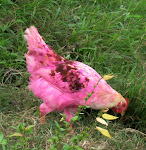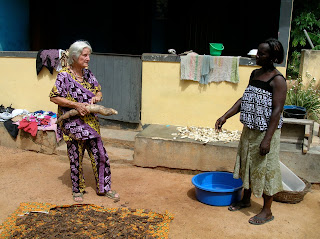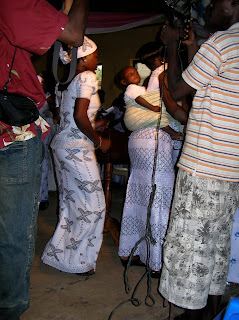
On March 30, we went to visit Jennifer, DeeDub's home-stay mother. When DeeDub first came to Ghana, she went to stay with a family for a period of time. Jennifer, pictured left, is a school teacher and lives with her extended family in a matriarchal compound. Below is Jennifer's mother and her daughter, Patience. Another daughter, Faustina, is trying to get into nursing school. Jennifer is very entrepreneurial and is growing cocoa plants to sell. She also raises chickens.
The compound is made up of several buildings surrounding a central area (shown to the right). Patience is ill and has lost an enormous amount of weight. Doctors have not yet been able to diagnose her illness, but Jennifer has prepared a herbal root and dried cassava to help treat her.
We stayed for a short visit and then caught a taxi back to Osien, where DeeDub was trying to see Madame Teresa about providing pizza for a girl's camp DeeDub is planning. Madame Teresa was not there, but it starting pouring rain, so we decided to share a beer and wait it out before catching a Tro back to Adjeikrom.
On the morning of March 31, we ran out of propane. DeeDub had been hearing that there was a significant shortage of propane and that people were having a hard time getting it. Osa came and took DeeDub's tank and the tank from the kitchen building and embarked on the project of trying to find some. DeeDub had to give him travel money (Tros and/or taxis) in addition to money for the propane so he could travel around on his search.
In the meantime, we set out to go to a dedication of a new kindergarten building that a couple of Peace Corps volunteers had built (both by raising money and through their labor). This couple, Marian and Alan Ruge, are stationed in Brekumanso and the school is in KwakuSae. We caught a Tro from Adjeikrom to Koforidua, where we changed to a Tro going to Asamankese. After a lot of confusion regarding how to pronounce the names of the various destinations, we were let off at the junction to KwakuSae. We then started hiking up the dirt road (in the noon-day sun, of course) to the school. I think we walked a good 20 minutes before I started hearing drums in the distance. We were quite relieved when the Peace Corps Country Director, Mike, and his driver, Kofi, stopped and picked us up to drive us the rest of the way. Whew! Air conditioned splendor!
There were quite a few people there singing and dancing. The building in the background of the first shot is the existing school building. The second picture is the new kindergarten building.

We retired to the room on the far right and had meat patties and soft drinks. The event was starting much later than originally planned because the dignitaries were late in arriving. One group was from the Presbyterian Church. Apparently the school was founded by Presbyterians. Below are some women wearing fabric that commemorates their church. Apparently it is quite common for the "church ladies" to have clothes made of fabric made to order by churches.
Once they arrived, there was a series of speeches, all of which were quite moving. Everyone praised Marian and Alan for their dedication and very hard work and encouraged residents to continue to support improvements to the school system. They even got the main political figure that was there to commit to providing computers!
Mike and his driver gave us a ride to Koforidua, where we spent the night at the "Partners May" hotel. What a trip!
We went to the restaurant and asked if they had white wine. All they had that was anything close was warm champagne. We then asked if they had gin and tonic. The man said he'd have to call the bar. So, we walked to the bar which was down the driveway, close to the road. A young woman was finally able to serve us each a jigger of dry gin (they don't know what gin is) and a bottle of fruit juice (no ice). We enjoyed it! DeeDub went back up to the restaurant and got a menu so we could decide what we wanted and allow plenty of time for food preparation. She very wisely suggested that we choose backups as it turned out all of our choices were "finished." The only thing available was fried fish (tilapia), which turned out to be quite tasty. It was a challenge eating though, since we decided to eat outside at the bar and there was no light. Picking around the fish heads and bones was slow going, but it was good.
The morning of April 1, we went downstairs and had the breakfast before taking a cab into the part of Koforidua near the Krobodan Internet Cafe. Kathryn, a Peace Corps volunteer, has an office at this facility. In addition to the internet cafe project, this organization (Dutch, I think) has women who make jewelry. There are tons of non-profit organizations that are set up to help Ghana develop. Volunteers come from all over the world, not just the Peace Corps.

We met Rebecca (another Peace Corps volunteer) at the internet cafe and she took me to the bead market. Rebecca also works with women who make and sell beads. Anyway, her assistance was great and I was able to buy lots of beautiful beads at a very reasonable price. She's a monster bargainer!
Rebecca also helped me buy some beautiful fabric.
Later, after we returned to the internet cafe and met Kathryn, the four of us went to lunch.
These women are great (Kathryn left, DeeDub and Rebecca right)! They provide enormous support for each other: exchanging magazines, picking up mail in Accra for each other, and texting each other to exchange ideas. Although they are stationed in different villages, they get together periodically. Neat!




























